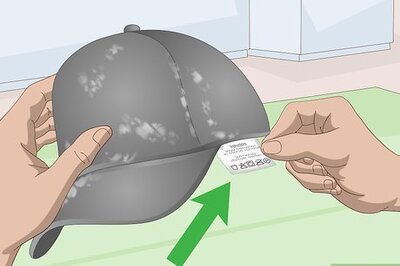
views
What are Gashadokuro?
A Gashadokuro is a giant skeleton from Japanese mythology. According to legend, a Gashadokuro (or “starving skeleton” in English) is a spirit (or yokai) that takes the form of a giant skeleton, comprised of the skulls of people who died in battle or of starvation. Gashadokuro stand over 10 meters (33 ft) tall and roam around at 2 a.m. to attack and eat any humans they come across. They can turn invisible and are practically indestructible. Size: 10 meters (33 ft) tall Appearance: Giant skeleton made from the skulls of the dead. Because they’re so tall, sometimes only their eyes are visible, which are often described as burning yellow or green. Powers: Invisibility, indestructibility Behaviors: Their bones and teeth make a “gachi gachi” clattering sound as they move, though they’re usually silent when stalking prey. They will continue hunting their prey until their pent-up anger is released, which causes their bones to collapse. Weaknesses: Shinto talismans, sunlight
Gashadokuro are formed from angry spirits. When soldiers die in battle or people die of famine, they rarely receive proper burial rites. Because of this, their spirits are unable to pass on and become angry and vengeful. As their bodies decay, their anger turns into a grudge against the living, which in turn twists them into a supernatural force. The bones of hundreds of victims gather together in one mass and form a Gashadokuro. Because of how they’re created, Gashadokuro are often found near battlefields or mass grave sites.
Gashadokuro Origins & Legend
The first Gashadokuro myth dates back to the 10th century. In the 10th century, the government in Kyoto put a bounty on samurai Taira no Masakado’s head after he led an armed revolt. His cousin decapitated him and brought his head to the capital for a reward. Takiyasha Hime, Maskado’s daughter and a powerful sorceress, was infuriated by her father’s murder and conjured the first Gashadokuro with the bones of those who died in battle alongside Masakado. As revenge, she released the Gashadokuro on the city. The Gaskadokuro continued to ravage the city until Masakado’s head was moved to Shibasaki, or modern-day Tokyo. The head became somewhat of a demigod, with a grave still standing today near the Tokyo Imperial Palace. This legend is a semi-historical account, based on true events.
Gashadokuro in Pop Culture & Art
Gashadokuro first appeared in print in 1966. In 1966, Gashadokuro and other Japanese spirits were mentioned in an article called “A Special Feature on Japanese Yokai Beside You” in the magazine Bessatsu Shoujyo Friend. The Gashadokuro went on to appear in many other articles in the 60s and 70s.
A Gashadokuro appears in the Takiyasha the Witch and the Skeleton Spectre triptych. There are many depictions of Gashadokuro in art, but one of the most well-known is a triptych of prints by Kuniyoshi Utagawa, entitled Takiyasha the Witch and the Skeleton Spectre (1844). The artist depicts the princess invoking the giant skeleton to protect her palace from enemies, and it is currently a part of the British Museum’s art collection.
Gashadokuro are antagonists in many anime series. Gashadokuro are a prominent part of modern-day pop culture, mainly appearing as antagonists in various media, including anime, manga, and video games. Portrayals of the starving skeleton can be seen in the 1994 animated film Pompoko, mangas One Piece and Inu x Boku SS, and the video games The Legend of Zelda: Majora’s Mask and Dark Souls 3.
How to Survive a Gashadokuro Encounter
Ward off Gashadokuro with a Shinto talisman. Because Gashadokuro are made of the skulls of the dead, they are not technically living and therefore cannot be killed. However, some sources claim that wearing Shinto talismans or charms can ward off these giant skeletons and protect you from harm. While no specific talismans are listed, it can be assumed you would visit a Shinto temple to find a protective charm. In addition to warding off Gashadokuro, Shinto talismans are believed to take away their invisibility. Other sources say only Shinto priests have the power to ward off Gashadokuro.
Listen for the clanking of its bones and teeth. A Gashadokuro’s bones and teeth rattle as it moves, making a “gachi gachi” clattering sound. If you’re out at night, listen for this sound to tell when a Gashadokuro is near. They’re typically silent when stalking their prey, so if you hear them, you may still have time to escape unnoticed. Some report that you can also feel a Gashadokuro’s approach through vibrations in your ears.
Evade the Gashadokuro until daylight. Gashadokuro hunt at night, and according to many sources, one of their only weaknesses is sunlight. If you’re being chased by a Gashadokuro, don’t stop running! Keep evading the starving skeleton until sunrise.
Avoid battlegrounds and mass burial sites. Gashadokuro are formed from the skulls of fallen soldiers and those who died from famine, so they’re known to linger around battlegrounds and mass grave sites. Decrease your chances of a Gashadokuro attack by avoiding these areas, especially at night.
Prevent Gashadokuro attacks by giving the dead proper burials. While this won’t help if you’re already being attacked by a Gashadokuro, respecting the dead can prevent more Gashadokuro from rising. If you come across a set of bones that have been improperly buried, perform respectful burial rites to help the spirit rest.
Are Gashadokuro real?
There is no evidence that Gashadokuro are real. While Gashadokuro appear in many Japanese legends and modern-day pop culture, there is no scientific evidence that they are real. Rather, they are an important part of Japanese culture, just like many other scary mythical creatures. That being said, the first legend of the Gashadokuro is based on truth, as it was inspired by the death of samurai Taira no Masakado.




















Comments
0 comment